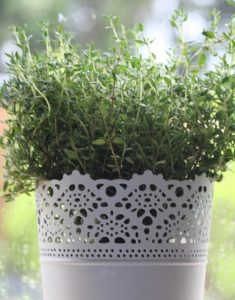Growing Rosemary & Thyme: A Practical Guide For Beginners

Table of Contents
Choosing the Right Location and Soil for Rosemary and Thyme
The success of your rosemary and thyme plants begins with choosing the right spot and preparing the soil. These Mediterranean natives have specific preferences that, once met, will reward you with years of flavorful herbs.
Sunlight Requirements
Both rosemary and thyme thrive in full sun, needing at least 6-8 hours of direct sunlight daily. Consider south-facing locations (in the Northern Hemisphere) for optimal growth. Sunlight is crucial for the essential oil production that gives these herbs their distinctive aroma and flavor.
- Partial shade can be tolerated, but less sunlight may result in weaker growth and less flavorful herbs.
- Observe your garden's sunlight patterns throughout the day before planting to find the sunniest spot.
Soil Preferences
Well-draining soil is crucial for healthy rosemary and thyme. Avoid heavy clay soils that retain too much moisture, which can lead to root rot, a common problem for these herbs. Sandy loam or a mix of garden soil and perlite is ideal. Good drainage is key to preventing fungal diseases.
- Amend heavy clay soil with compost or other organic matter to improve drainage and aeration. This will help create a more suitable environment for root growth.
- Check your soil's pH – slightly alkaline soil (pH 6.0-7.5) is best for both herbs. You can purchase a soil testing kit to accurately determine your soil's pH.
Container Growing
Rosemary and thyme can also thrive in containers, offering flexibility for those with limited garden space or challenging soil conditions. This is a great option for those who live in apartments or have small yards.
- Use pots with drainage holes to prevent waterlogging.
- Choose a well-draining potting mix specifically formulated for herbs or add perlite to improve drainage.
Planting Rosemary and Thyme
Once you've selected the perfect location and prepared the soil, it's time to plant your rosemary and thyme. There are several methods you can choose from, each with its own advantages.
Starting from Seed
Sowing seeds indoors 6-8 weeks before the last expected frost allows for a head start, especially in cooler climates. This gives the plants a chance to establish themselves before being transplanted outdoors.
- Use a seed-starting mix and keep the soil consistently moist but not soggy.
- Thin seedlings once they have a few true leaves to prevent overcrowding and ensure healthy growth. Give each seedling enough space to thrive.
Starting from Cuttings or Plants
Purchasing established plants or taking cuttings from healthy rosemary and thyme plants offers faster results and a higher success rate than starting from seed. This is often the preferred method for beginners.
- Cuttings should be taken from non-flowering stems and planted in moist soil or water until roots develop.
- Ensure proper spacing between plants (see below) to allow for adequate air circulation, which helps to prevent fungal diseases.
Planting Depth and Spacing
Plant rosemary and thyme at the same depth they were growing in their containers. Proper spacing is essential for healthy growth and prevents competition for resources.
- Space rosemary plants 12-18 inches apart.
- Space thyme plants 6-12 inches apart.
Caring for Rosemary and Thyme
While rosemary and thyme are relatively low-maintenance, providing the right care will ensure healthy growth and a bountiful harvest.
Watering
Water regularly, especially during dry periods, but avoid overwatering. Allow the soil to dry slightly between waterings to prevent root rot. Overwatering is a common mistake that can harm these drought-tolerant herbs.
- Check the soil moisture with your finger before watering. Water thoroughly when the top inch or two of soil feels dry.
- Overwatering can lead to root rot and fungal diseases. Good drainage is essential to prevent this.
Fertilizing
These herbs are relatively low-maintenance and don't require heavy fertilization. Their natural resilience means they can thrive with minimal nutrients. However, a light application of balanced fertilizer in spring can promote healthy growth.
- Over-fertilizing can result in lush growth but less flavorful herbs.
- Compost tea is a natural and effective fertilizer option that provides essential nutrients without harsh chemicals.
Pest and Disease Control
Rosemary and thyme are generally resistant to pests and diseases. Good air circulation, achieved through proper spacing and pruning, helps prevent problems.
- Inspect plants regularly for signs of pests or diseases. Early detection is crucial for effective treatment.
- Use organic pest control methods if necessary. Neem oil is an effective organic insecticide.
Harvesting and Preserving Rosemary and Thyme
Harvesting your rosemary and thyme is a rewarding experience that allows you to enjoy the fruits (or rather, herbs!) of your labor.
Harvesting
Harvest sprigs throughout the growing season, taking only what you need. Regular harvesting encourages bushier growth and prevents the plants from becoming woody. Pinch back stems to stimulate new growth.
- Harvest rosemary and thyme in the morning after the dew has dried. This helps prevent the spread of diseases.
- Avoid harvesting too much at once to allow the plants to recover.
Preserving
Dry harvested herbs in a cool, dark, and well-ventilated area. Alternatively, you can freeze herbs by chopping them and storing them in freezer-safe bags. Preserving your harvest extends the enjoyment of your homegrown herbs.
- Dried herbs can be stored in airtight containers for several months.
- Frozen herbs maintain their flavor for up to a year.
Conclusion
Growing rosemary and thyme successfully is within everyone's reach! By following these simple steps and focusing on the right location, soil, and care practices, you can enjoy a bountiful harvest of these fragrant and versatile herbs. From creating delicious meals to using them in natural remedies, the possibilities are endless. Start your own fragrant herb garden today and experience the joy of growing your own rosemary and thyme! Remember to always research specific growing needs based on your region and climate for optimal results in your journey of growing rosemary and thyme.

Featured Posts
-
 Learn Skywarn Spotter Skills With Tom Atkins
May 31, 2025
Learn Skywarn Spotter Skills With Tom Atkins
May 31, 2025 -
 Munguia Faces Doping Accusation His Response
May 31, 2025
Munguia Faces Doping Accusation His Response
May 31, 2025 -
 Nyt Mini Crossword Answers March 18 2025
May 31, 2025
Nyt Mini Crossword Answers March 18 2025
May 31, 2025 -
 Sanofi Advances Respiratory Pipeline With Asthma Data And Copd Study Plans
May 31, 2025
Sanofi Advances Respiratory Pipeline With Asthma Data And Copd Study Plans
May 31, 2025 -
 Deutsche Stadt Lockt Mit Kostenloser Unterkunft Neue Einwohner An
May 31, 2025
Deutsche Stadt Lockt Mit Kostenloser Unterkunft Neue Einwohner An
May 31, 2025
